Jump to
S2C1
Energy calculated at CCSD(T)/cc-pVDZ
| | hartrees |
|---|
| Energy at 0K | -5182.939864 |
| Energy at 298.15K | -5182.944861 |
| HF Energy | -5182.519599 |
| Nuclear repulsion energy | 322.321617 |
The energy at 298.15K was derived from the energy at 0K
and an integrated heat capacity that used the calculated vibrational frequencies.
Geometric Data calculated at CCSD(T)/cc-pVDZ
Point Group is C2v
Cartesians (Å)
| Atom |
x (Å) |
y (Å) |
z (Å) |
|---|
| C1 |
0.000 |
0.000 |
1.012 |
| Br2 |
0.000 |
1.571 |
-0.087 |
| Br3 |
0.000 |
-1.571 |
-0.087 |
Atom - Atom Distances (Å)
| |
C1 |
Br2 |
Br3 |
| C1 | | 1.9168 | 1.9168 |
Br2 | 1.9168 | | 3.1411 | Br3 | 1.9168 | 3.1411 | |
 More geometry information
More geometry information
Calculated Bond Angles
| atom1 |
atom2 |
atom3 |
angle |
|
atom1 |
atom2 |
atom3 |
angle |
| Br2 |
C1 |
Br3 |
110.039 |
|
Electronic energy levels
Charges, Dipole, Quadrupole and Polarizability
Jump to
S1C1
Energy calculated at CCSD(T)/cc-pVDZ
| | hartrees |
|---|
| Energy at 0K | -5182.916604 |
| Energy at 298.15K | -5182.921629 |
| HF Energy | -5182.535644 |
| Nuclear repulsion energy | 313.035206 |
The energy at 298.15K was derived from the energy at 0K
and an integrated heat capacity that used the calculated vibrational frequencies.
Geometric Data calculated at CCSD(T)/cc-pVDZ
Point Group is C2v
Cartesians (Å)
| Atom |
x (Å) |
y (Å) |
z (Å) |
|---|
| C1 |
0.000 |
0.000 |
0.732 |
| Br2 |
0.000 |
1.677 |
-0.063 |
| Br3 |
0.000 |
-1.677 |
-0.063 |
Atom - Atom Distances (Å)
| |
C1 |
Br2 |
Br3 |
| C1 | | 1.8558 | 1.8558 |
Br2 | 1.8558 | | 3.3540 | Br3 | 1.8558 | 3.3540 | |
 More geometry information
More geometry information
Electronic energy levels
Charges, Dipole, Quadrupole and Polarizability
